2012 VOLKSWAGEN GOLF PLUS battery
[x] Cancel search: batteryPage 176 of 541
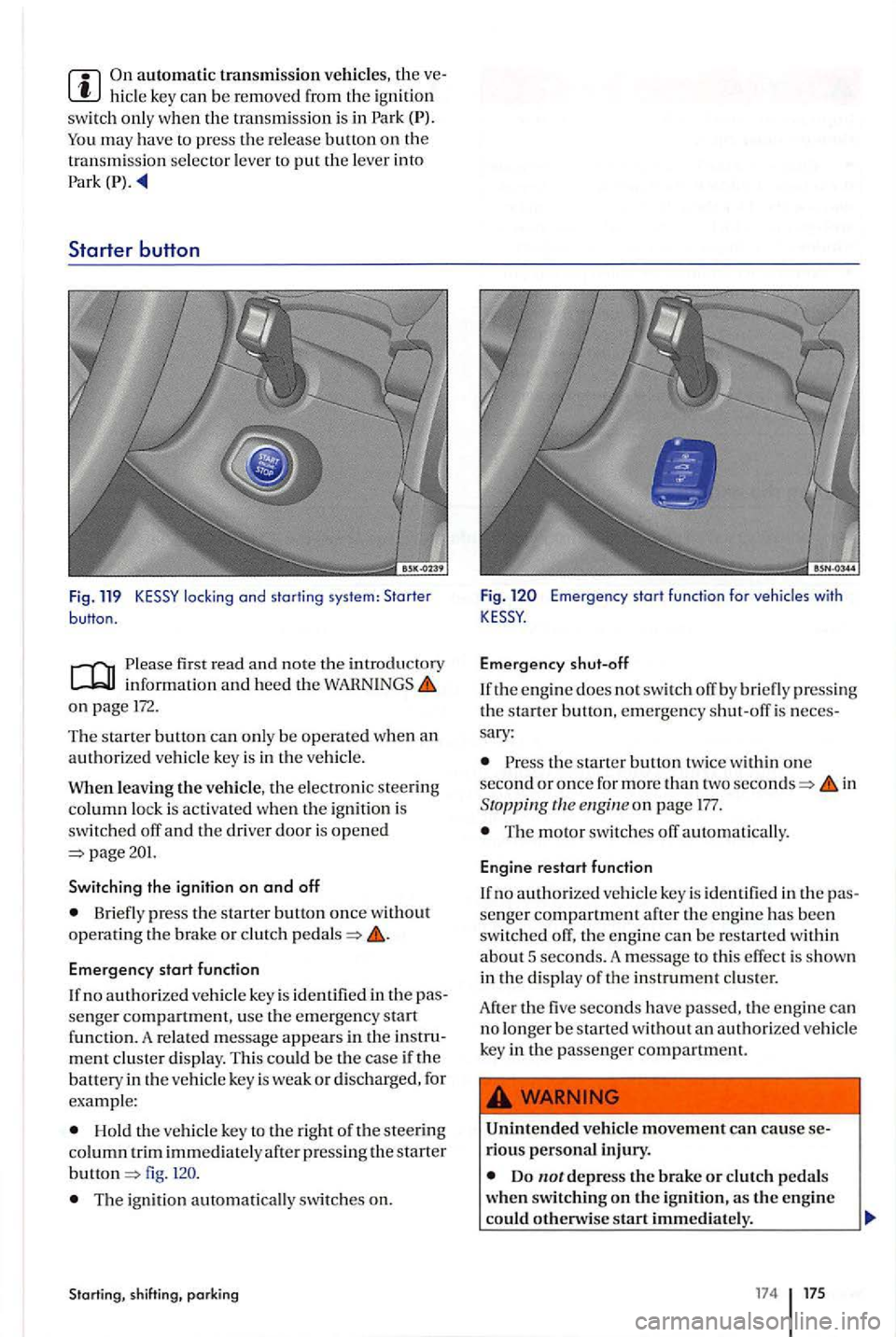
hide key can be removed from the ig nition
sw itch only when th e tra nsmiss ion is in Park
locking and starting system: Starter button.
first read and no te th e in trod uctory inform ation and heed the on page 172.
The starter button can only be opera ted when an authorized vehicle key is in t h e vehicl e.
leaving the ve hicl e, the e lectronic stee rin g
co lumn lock is ac tiva te d when th e ign ition is switch ed off and the driver door is opened page201.
Switching the ignition on and off
Briefly press the s ta rt er button once w ithout opera ting th e brak e or clutch
Emergency start function
If n o authorized vehicle key is identifi ed in the pas
se nger compartment, use th e e merge ncy start functio n . A re lated message appears in the in stru ment cluster disp lay. This could be the case if th e
battery in th e ve hicl e key is wea k or discharged, for
e xample:
Hold the vehicle key to the righ t of the stee rin g
column trim immedi a te ly after press ing the star te r button fig .
T he ign ition automatically switc h es on.
Starting, shi fting, parking
Fig . Emerge ncy start function for vehicles with
Emergency shut-o ff
If the en g ine does no t sw itch off by bri efly pre ssing the s tart er bulton, emergen cy shut-off is neces
sary :
the starte r buuon twice withi n one
second o r once for more than two seconds=> in Stoppingtlleengineon page 177.
The moto r switch es off automatically.
Engine restart function
If no authorized vehi cle key is identi fied in the pas
se nger compartment after the engine has been
switc hed off, the e ng in e can b e res ta rted w it hin about 5 seconds. A message to this effect is sh own
in the di sp lay of th e in stru ment clu ster.
After the five seconds hav e passed, the en gin e ca n
no longer be starte d without an authorize d ve hicle
key in the passenger compartment.
Unintended vehicl e movement can ca use se
rious personal inju ry.
Do
__ e_n_v_is_e_s_t_a_rt_i_m __
17 4 175
Page 201 of 541
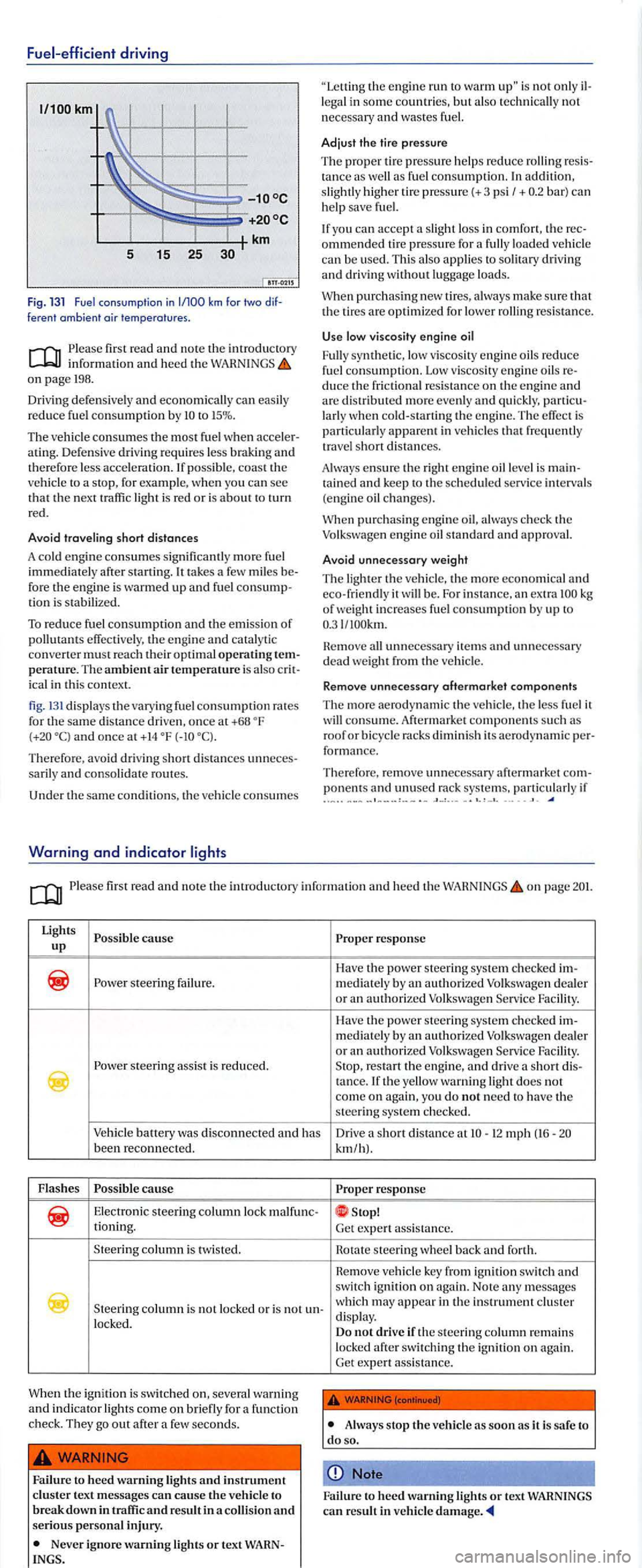
Fuel-efficient driving
Fig. 131 Fuel consumption in ferent ambient air temperatures .
info rmation and heed the on page 198.
Dri vin g defensive ly and economically can easily
r educe fuel con sumption by to 15 % .
The ve hicle consu mes the most fu el w he n atin g. D efe nsive dri vin g require s less brakin g and therefore less accelerat ion. If possib le, coast the ve hicle to a sto p, for exa mple, when yo u ca n see th a t th e next traffic ligh t is red or is about to turn
red.
Avoid traveling short distanc
es
A cold engine consumes sig nificantl y more fuel
imm ediately after sta rtin g. It take s a few miles fore the engi ne is warm ed up and fuel tion i s stabili zed.
To reduce fuel consumptio n and the emission of pollutants effect ive ly, the e ng in e and ca talytic
conve rter must reach th eir optimal operating
ica l in thi s context.
fig. 13 1 displays the v a ry ing fuel consumption rates
for the same d istance dri ven, once at +68 and once at + 14
th e e ngin e run to warm is not o nl y lega l in some co untries, but also technicall y not
n ecessary and wastes fu el.
Adjust the tire pres sure
T he prop er tir e
pressure help s reduce rollin g tance as well as fue l co nsumption. In additi on ,
slig htl y higher tire pressure(+ 3 psi I+ bar) ca n
h e lp save fuel.
If you ca n a ccept a slight los s in comfort, the ommend ed tir e pressure for a fully loade d ve hicl e
ca n be used. This als o applies to so litary dri vin g and driv ing withou t lu ggage loa ds.
When purchasing new t ires, alway s ma ke sure th at
th e tires are optimi zed for lower rollin g resis tance.
Us e low viscosity engine oil
F ull y sy nth e
tic, low viscosity e ngine oils reduce
fuel consumption. Low viscosity e ngin e oils duce the fric tional res istance on th e engine and are dis tributed m ore evenly and qui ckly, larly w hen co ld -s tarting the engine. The effect is parti c ularl y apparent in vehicles th at frequentl y
tra vel s hort dis tan ces.
A lways ens
ure th e righ t e n g in e oil leve l is ta in ed and keep to the sc h edul ed serv ice interva ls
(e ng ine oil ch an ges).
W
hen purch asing e ngine oil, always ch eck th e Volksw agen en gine oil standard and approval.
Avoid unnecessary weight
The lighter th e ve hicl e, th e more economica l and ceo-friend ly it w ill be. For in stance, an extra
H e m ove
consum e. Aftermark et co mponents s uch as
ro of or b icycle racks dimin is h its aerod yn a m ic fonnan ce.
Th erefo re, re
mov e un necessary aftermark e t ponents and unused rac k systems, parti cul arly if ....... -
fir st read and note th e introductory informa tion and h ee d th e WAHNINGS page
response
Ha ve the power stee rin g sys te m ch ec ked ste eri ng failure. mediatel y by an authori zed Volk swag en deale r
o r a n authorized Volk swagen
Fac ility. steeri ng ass is t i s reduced. re start the e n gine, and dri ve a sh ort tan ce. If th e yello w warning light does not
c o m e on again, you do not need to have th e
s te ering syste m ch ec ke d .
Vehicle battery was di sconnected and has Drive a short distan ce at 12 mph been reconnec te d . km/h).
F lashes re sponse
Elec troni c steering column lo ck malfunc -
which m ay appea r in the in strument clu ste r
di sp lay. loc ke d.
W
hen the i g nit ion is switc h ed on, seve ra l wa rnin g and indicator lights come on bri efly for a f un ction ch e ck . T hey go out after a few seconds.
Failure to
heed warning light s and in strument cluster text m essages can cause th e vehicl e to break down in t raffic and result in a collisio n and seriou s personal injury.
Neve r igno re warning lights or tex t
Do not dri ve if th e s teerin g co lumn remains
l ocke d switch in g th e ig niti on on aga in.
Ge t expert assis ta nce.
Alwa ys sto p the vehicl e as soon as it is safe to do so .
Note
Failur e to heed warning lights or tex t WARNINGS can res ult in vehicl e damage
Page 240 of 541
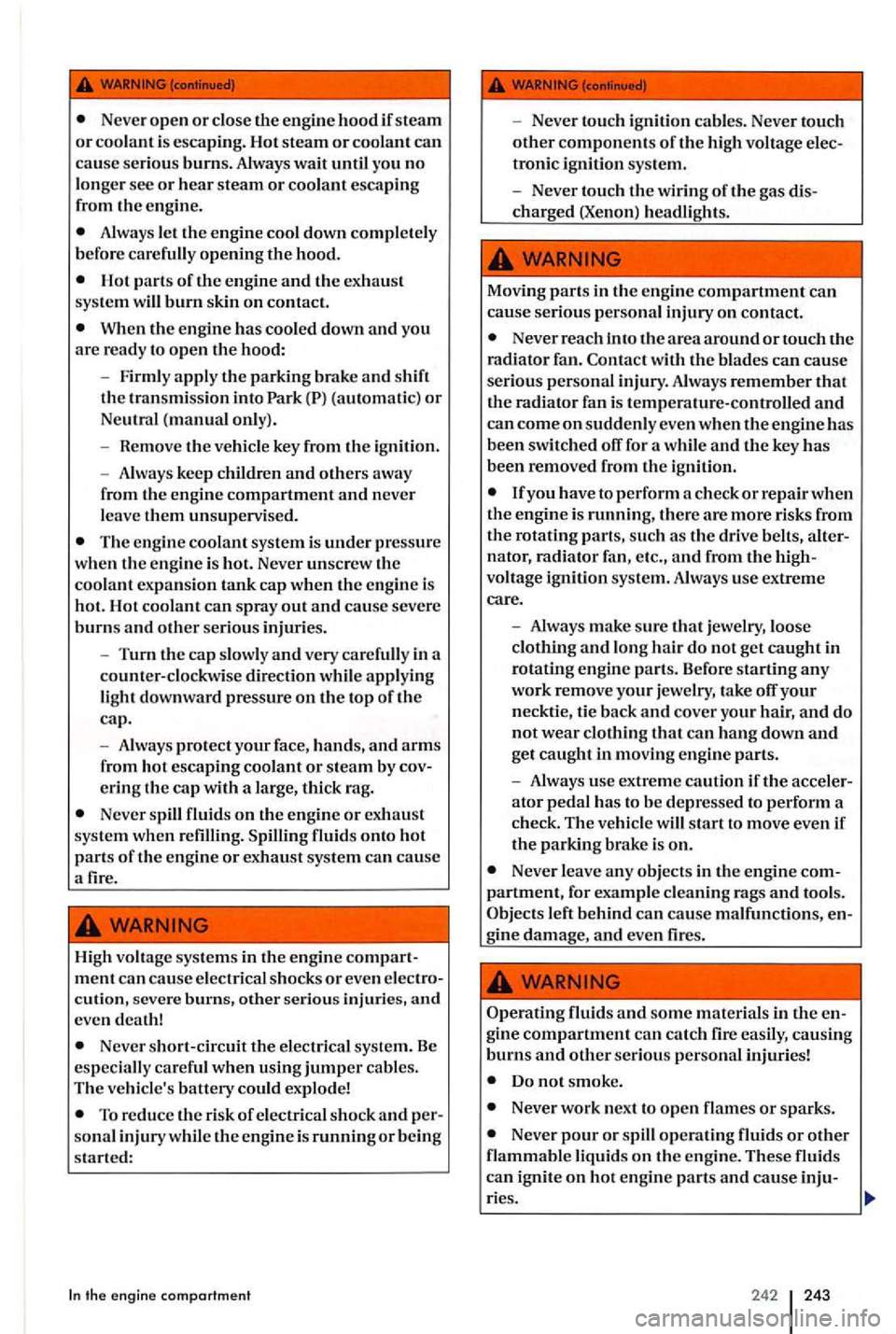
Never open or close the engine hood if steam or coolant is escaping. Hot steam or coolant can cause serious burns. Always wait until you no longer sec or hear steam or coolant escaping
from the engine.
Hot parts of the engine and the exhaust
system will burn skin on contact.
When the engine has cooled down and you are ready to open the hood:
- Firmly
apply the parking brake and shift the transmission into Park
The engine coolant system is under pressure when the engine is hot. Never unscrew the coolant expansion tank cap when the engine is
hot. Hot coolant can spray out and cause severe burns and other serious injuries.
- Turn
the cap slow ly and very carefully in a
counter-clockwise direction while applying
light downward pressure on the top of the cap.
- A
lways protect your face, hands, and arms from hot escaping coolant or steam by
Never spill fluids on the engine or exhaust
system when Spilling fluids onto hot parts of the engine or exhaust system can cause a fire.
High voltage systems in the
engine com ment can cause electrical shocks or even
Never short-circuit the electrical system. Be especially careful when using jumper cables. The vehicle's battery could explode!
To reduce the risk of electrical shock and sonal injury while the engine is running or being started:
the engine compartment
- Never touch ignition cables. Never touch other components of the high voltage tronic ignition system.
- Never touch
the wiring of the gas
Never reach into t11e area around or touch the
radia tor fan. Contact with the blades can cause serious personal injury. Always remember that the radiator fan is temperature-controlled and can come on suddenly even when the engine has been switched for a while and the key has been removed from the ignition.
lfyou have to perform a check or repair when the engi ne is running, there are more risks from tl1e rotating parts, such as the drive belts, nator, radiator fan, etc ., and from voltage ignition system. Always use extreme care.
- Always make
sure that jewelry, loose clothing and long hair do not get caught in rotating engine parts. Before starting any work remove your je welry, take
parking brake is on.
Never leave any objects in the engine
left behind can cause malfunctions,
Do not smoke.
Never work next to open flames or sparks.
Never pour or spill operating fluids or other flammable liquids on the engine. These fluids can ignite on hot en g in e parts and cause ries .
242 243
Page 241 of 541
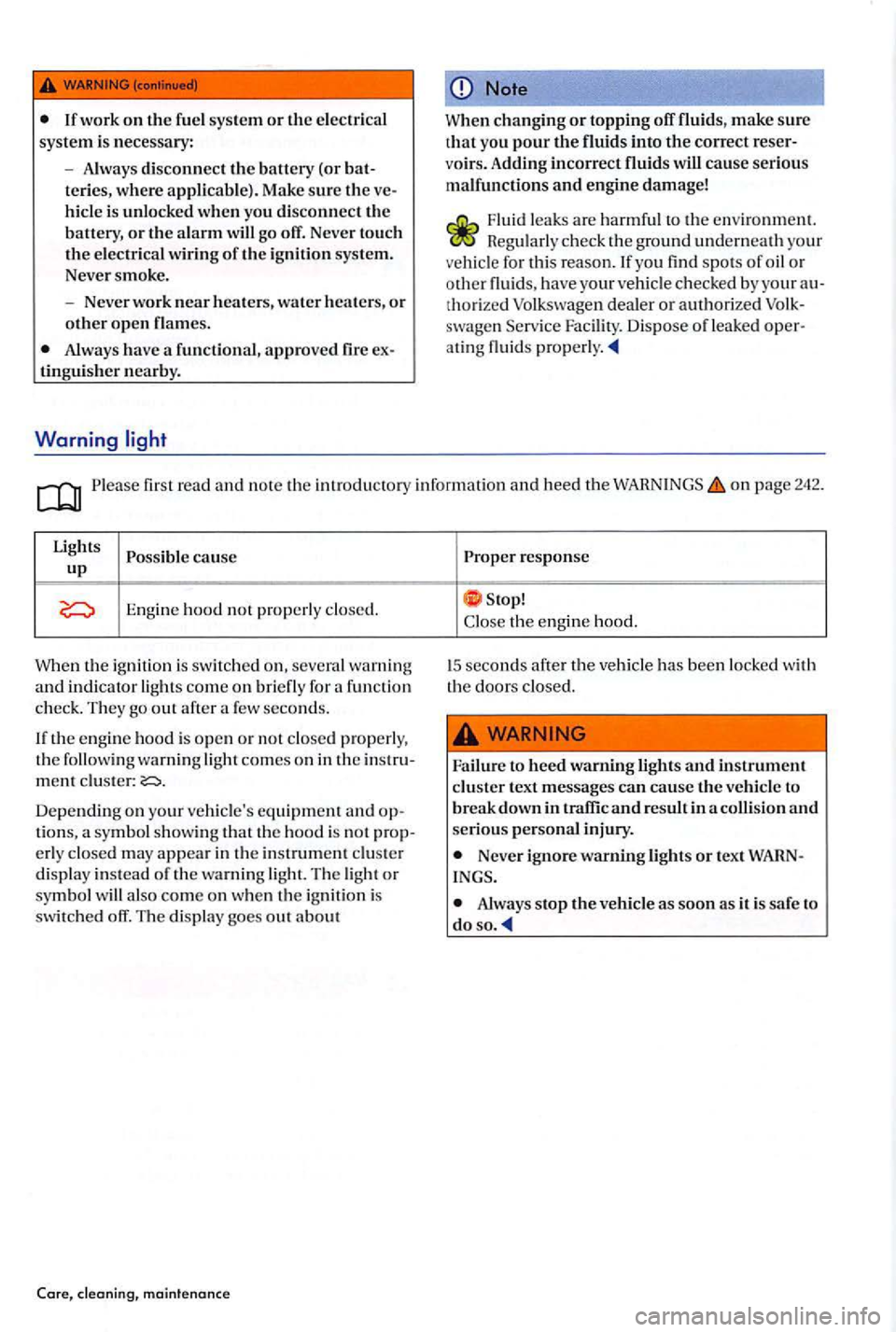
Always disconnect the batt ery (or teries, where appli cable). Make sure the hicle is unlocked when you disconnect the battery, or th e alarm w ill go off. Never touch the electrica l w irin g of the ign ition sys te m .
Neve r smoke.
Never work near heaters, water heaters, or other open flames.
Always have a functional, approved fire tinguisher nearby.
Warning
Note
W hen c
hangin g or topping off fluid s, make sure that you pour the fluids into the correct voirs. Addin g incorrect fluids will cause serious
malfunc tions and engine damage!
Fluid leaks are harmfu l to the environm ent.
thori zed Volkswagen dealer or authori zed swagen Serv ice Faci lity. Dispose of le aked at ing fluid s
first read and note the in tr o du ctory informat io n and heed th e on p age 242.
Lights ca use up
Engine hood not proper ly closed.
When the ignition is sw
itched on, several warning
a nd in dicator light s co me on bri efly fo r a functio n
c h eck. They go out after a few seconds.
If th e engi ne hood is open or not clos
ed properly,
the following warning light comes on in the ment cluster:
tions , a sy mbol showing th at the hood is not erly clo sed may appea r in th e in stru ment clu ste r
di splay instead of the warnin g light . Th e light or sy mbo l will als o com e o n whe n th e ig nition is swit ched off. T he di splay goe s out about
Core,
response
Close the eng ine hood.
I S seconds
after the vehicle has been locked with
the doors closed.
Failure to heed warning lights and instrument cluster text messages can cause the vehicle to
break down in traffic and res ult in a co llision and se riou s personal injury.
Never ignore warning lights or text
Always stop the vehicle as soo n as it is safe to do
Page 254 of 541
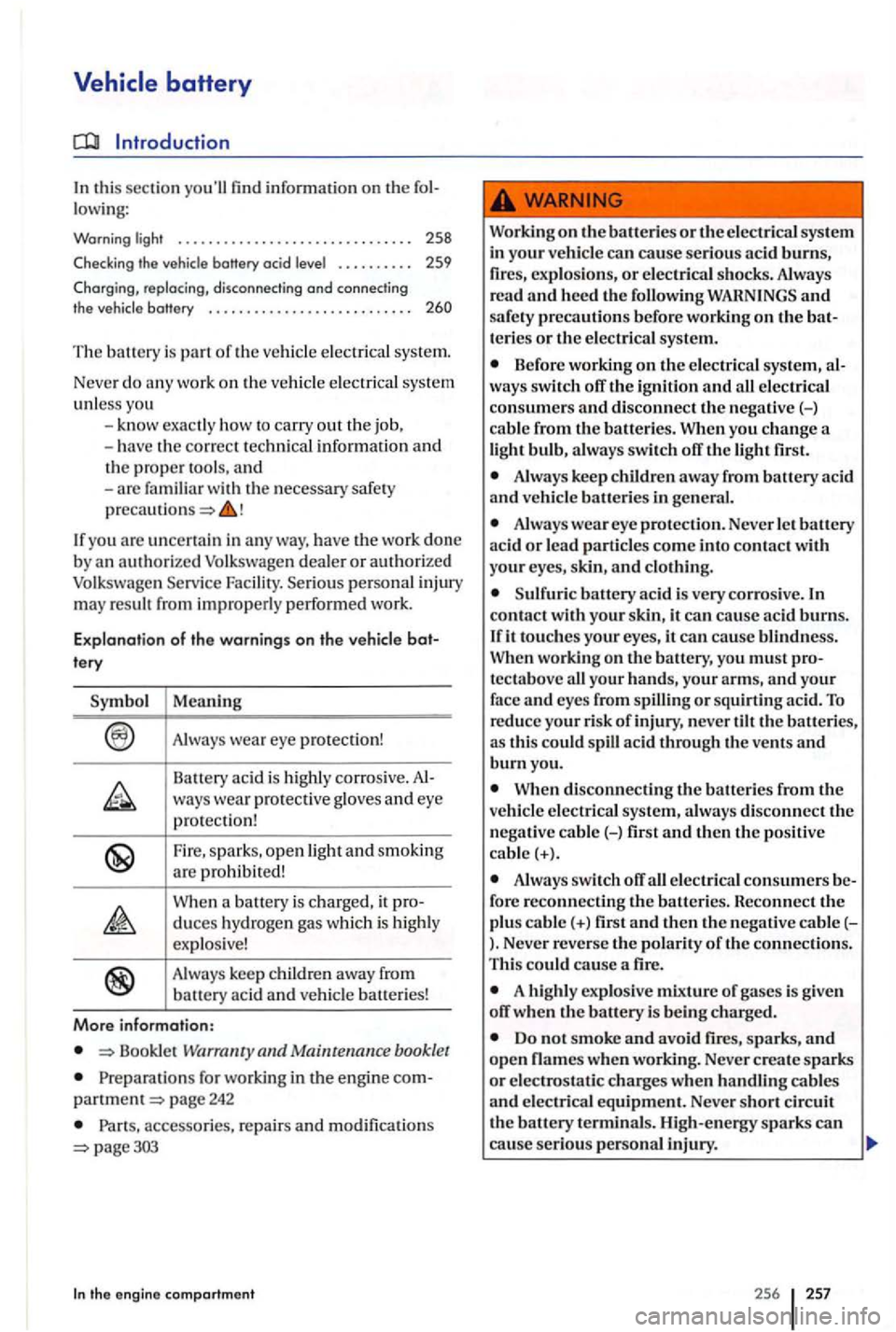
th is sect io n yo u'll find inform ation on th e low ing:
Warning light . . . . . . . . . . . . . . . . . . . . . . . . . . . . . . . 258
Check ing . . . . . . . . . . 2 59
Charg ing, replacing, disconnect ing
and c o nn ecti ng the ve hicle boHery . . . . . . .. . . . . . . . . . . . . . . . . . . .
you are uncerta in in anyway , have the work do ne an aut ho rized Volk swage n dealer or au th orized
Volkswage n Service Serious personal
tery
Symbol Meaning
Always wear eye protectio n!
B a tt ery
acid is hi ghl y co rro sive. ways wear protective gloves and eye protec tion !
Fire, sparks, op en light and sm okin g
a re pro hibit ed !
W hen a batt ery is c ha rge d, it
Bookle t Warranty and Main tena nce book let
fo r worki ng in th e eng ine page 242
Par ts, acce ssories , repai rs and m odifica tio ns
or the electrical sys te m
in your vehicl e can cause seriou s acid burns,
fir es, explo sion s, o r electri ca l s hock s. Alway s
re ad and heed the followin g and safety preca ution s befor e working on
Before working on the ele ctri cal s ystem, way s switch off the ignition and all ele ctrical
consumers and di sconnect the negative
Alwa ys ke ep children awa y from
Always wear eye prot ection . Never let ballery
ac id or lead particles come int o contact with
your eyes, skin , and clothing .
Sulfuric battery ac id is ve ry corros ive . In
contac t with your skin , it can cause acid burns.
If it to uches your e y es, it can cau se blindn ess.
your hands, your arms, and your face and eye s from spillin g or squirtin g acid. To reduce your risk of injury , n eve r tilt the batteri es ,
as thi s could acid throu gh th e vents and burn you.
batterie s from the
v e hicle electri cal sys tem, always disconnect the negative cable H fir st and then the positive cable(+ ).
Always swit ch ofT electri cal con sumers for e reconnec tin g th e batt eri es. Reconnect the plu s cabl e(+) first and then th e nega tive cable().Neve r rev erse the pol arity of the connection s.
Thi s could cause a fire.
A highly explos iv e mixture of ga ses is give n
ofT wh en th e battery is be in g c harged.
D o no t s moke and avoid fires, sparks , and open names when wo rkin g. Never create sparks or ele ctros tati c charges when handlin g ca ble s and elec trica l equipm ent. Nev er short cir cuit the b att ery te rminal s. Hig h -energy s parks can
ca use seriou s pers on al injury.
256 257
Page 255 of 541

Never use or attempt to ch arge a damaged or frozen battery, or a battery was frozen but has thawed. a frozen or thawed battery could cause explosion s and ch emi cal burns! place damaged or froze n ba tt eri es m ediat ely. A disc harge d battery can freeze at
temperatures around +32 Alway s
the battery has a ve nt lin e or tube, make sure thi s is connec te d.
Always make sure that the vent line is curely attached to a cated in the
If you battery acid in your eyes or on your
eral minutes. The n medical attention
ical attention immedia te ly.
Warning
Battery posts, termin als and related rie s contain lead and lea d compon ent s, cals known to the of to cau se
cancer or other h arm . Wash your hand s after
handlin g.
Note
Never di scon nect a ba tt ery or connec t
two b atte ries to each other when th e
Do not expose the battery to dire ct light for an extend ed p eriod of tim e as ultraviolet rays may damage th e battery housing.
is lef t s tanding in the cold for a
lon g tim e, prote ct th e battery from
fr ee zin g. A battery will be permanentl y damaged by fr eez ing.
infunnatiun on pa ge 257 .
Light s cause up
Alternator malfunctio ning.
W he n th e ig niti on i s s witched on. several warning
a nd in dica tor lights come on briefly for a funct ion ch eck. T hey go out aft er a few seco nds.
Failure to hee d warning lights and instrument
Never ignore warning light s or tex t
cleaning, maintenance
to an authorized dea le r or authorized Volksw agen Fa-cilit y. Have e lectrical syste m ch ec ke d . off unnecessary elec trica l load s. Th e ve-battery will not be c ha rged by the alt er-nato r whil e th e is in moti on.
Always stop tl1e
Note
Failure to heed warning lights or te xt
Page 256 of 541
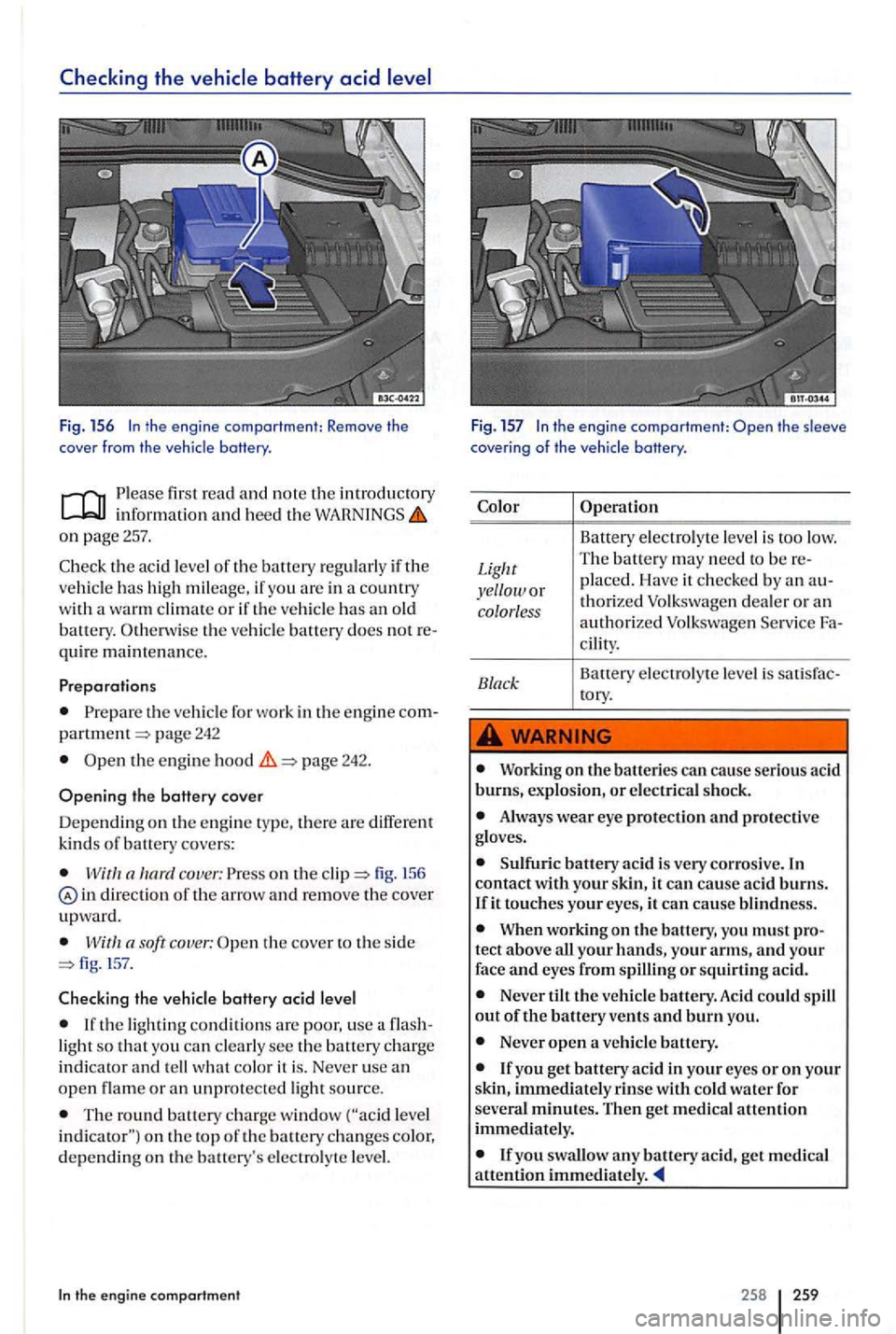
Checking the
the engine compartment: Remove the
cove r from the vehicle
first read and n o te th e introducto ry
o n p age 257.
the ve hicle battery does quire mainten an ce.
th e ve hicl e for work in th e engin e page 242
page 242.
the battery cover
De pending o n the e ng in e ty pe, there are different kinds of battery covers:
cove r: fig . 156 in directi o n of th e arrow and re m ove the cove r upward.
With a soft cove r: th e s ide
If the lighti ng conditi ons a re poor, use see the ba tt ery charge indicato r and w ha t co lor it is. Neve r use
The round ba tt ery ch a rge wind ow level
the engine compartm ent Fig
. 157
the engine compart ment:
p la ce d. Have it ch ec ke d by an thorize d Volkswagen deale r o r an authorize d Volk swage n cility.
Ba ttery electro ly te leve l is to ry.
Working on the batterie s can cause se riou s acid burns, exp lo sion, or electri cal shock.
Alway s wear eye protection and protective
glove s.
tect above a ll your hands, your arms, and your fa ce and eyes from spilling or squirting acid .
Never tilt the vehicl e battery. Acid could out of the battery vents and burn you.
Never open
258 259
Page 257 of 541
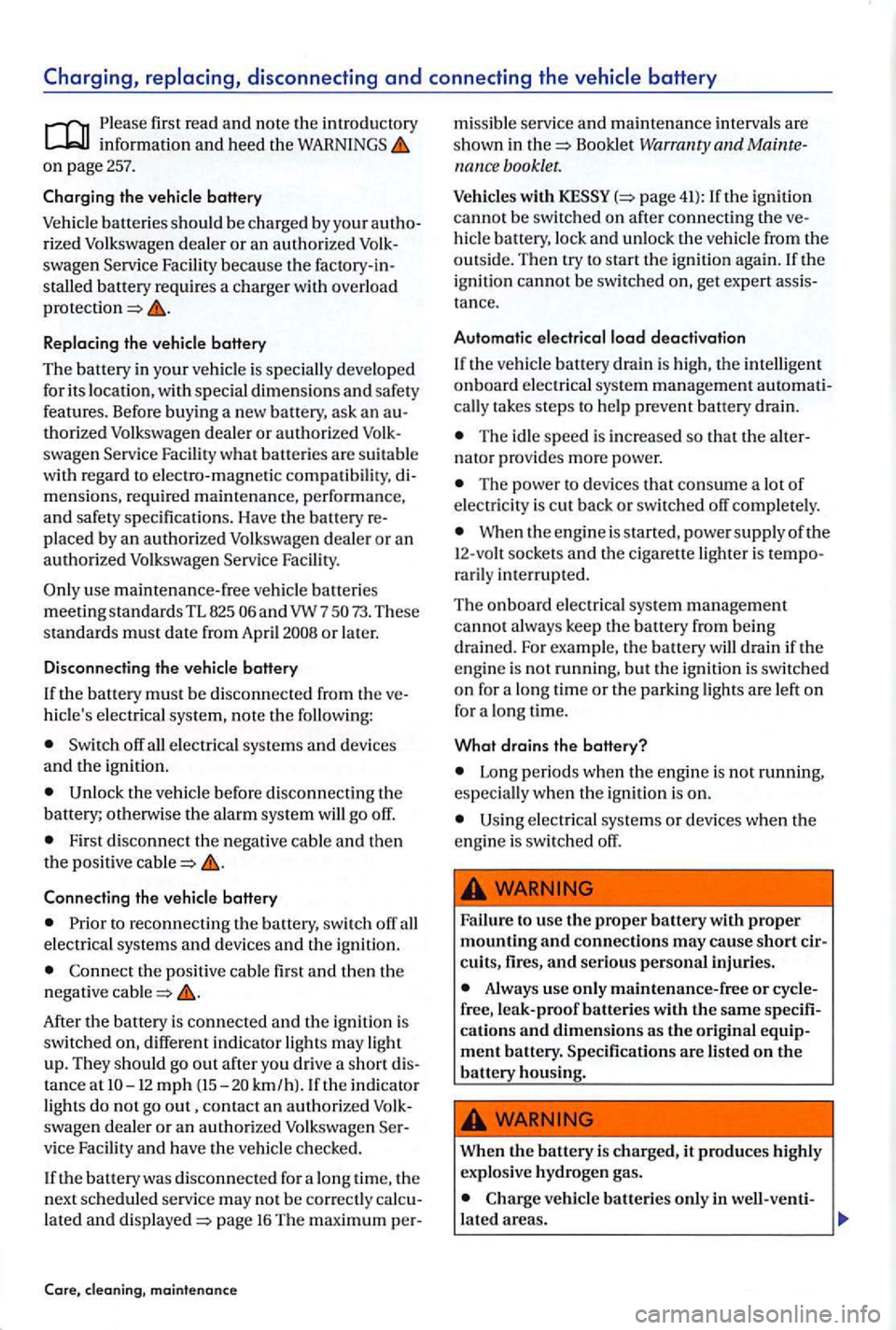
Charging, replacing, disconnecting and connecting the
first rea d and no te the introductory
o n p age 257.
the vehicle batte ry
Vehicl e batteries should be c harged by your rized Volk swagen deale r or an authorize d
Replacing the ve hicle battery
Th e batt ery in
your vehicl e is s pecially deve loped
f o r it s locati o n, w ith sp eci al dim ensio ns and safe ty
featu res. Befo re buy in g a new battery, ask an th ori ze d Volkswage n deale r o r authorize d swagen Facility w ha t batt eries are suit abl e
w ith r egard to e lectro-m agnetic compatibility, mension s, requir ed m aintenan ce, perfor man ce,
and safety sp ec ifications. H ave th e battery place d by an auth ori ze d Volkswage n deale r o r an authori zed Volk swage n Facility.
use m aint ena nce-free vehicl e ba tt eries m ee tin g standards T L 825
hicle's elec tri cal sys te m , note the following:
off all electrical syste ms and dev ices
and th e ign ition.
Fir st di sconnec t the negative cabl e and th en the positive
the vehicl e battery
to reconnecting the ba tt ery , switch off all elec trical sys te m s and dev ices and the ig niti on .
Con nec t th e positive cable fir st a n d then th e
n ega tive
ta n ce at mph (15-20 km /h).lf the in dica to r ligh ts do not go out, contact an auth orized swage n dealer or a n au th orize d Volkswagen v ice Facility and have the vehicle c hec ked.
If th e battery was discon necte d f or a long tim e, the
n ext scheduled se rvice may no t be correct ly la te d and page 16 The maximum per-
an d nance booklet.
Vehicles with
h icle battery, lock an d unloc k th e ve hicl e from th e outs id e. Th en try to sta rt the ig niti on again. If th e
ig niti on canno t b e switch ed on , ge t expe rt ta n ce.
Automatic electrical
load deactivation
I f t
he ve hicle battery drain is hig h, t he intelligent
o n board electrical sys te m m anage ment cally takes steps to help p reve nt b attery d rain.
The id le speed i s in creased so that the n ato r provides more powe r.
The power to dev ices that co nsume lot of e lec tricity is cut bac k or switched off com ple te ly.
W hen the en gine is s ta rt ed , p owe r supply oft h e
1 2-vo lt socke ts and t he c igare tte lighter is ra ril y int errupted.
T he on
board elec trica l sys tem man age men t
canno t always keep th e battery fro m being drained. For example, th e battery will drain if th e
e n g in e is not running, but th e ig ni tio n i s switc he d
o n for a lo ng tim e or th e parkin g lights a re left o n for a lo ng time.
What drain s th e battery?
Long period s w hen th e engine is no t running, especially w hen th e ig niti on is on.
Fa ilur e to use the proper batte ry with prop er mounting and connecti ons may ca use short seriou s personal injurie s.
Always use only mainten ance- free or leak-pro of batteries with the same
ment battery. Specification s are liste d on the
b attery ho using.
Wh en th e battery is charged, it produces hi ghly explosive hydroge n gas.
Charge ve hicl e batte ries only in w ell-ve nti-
l a te d areas.